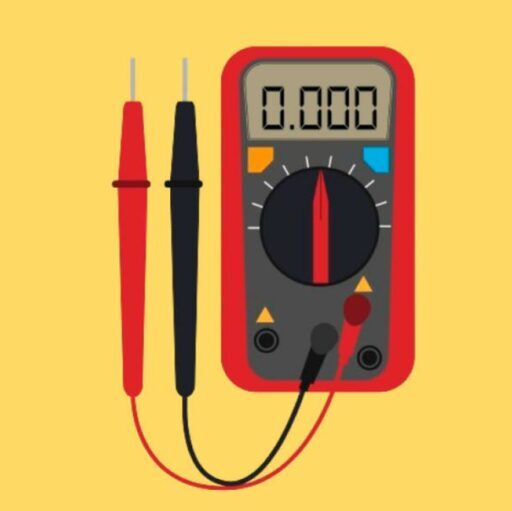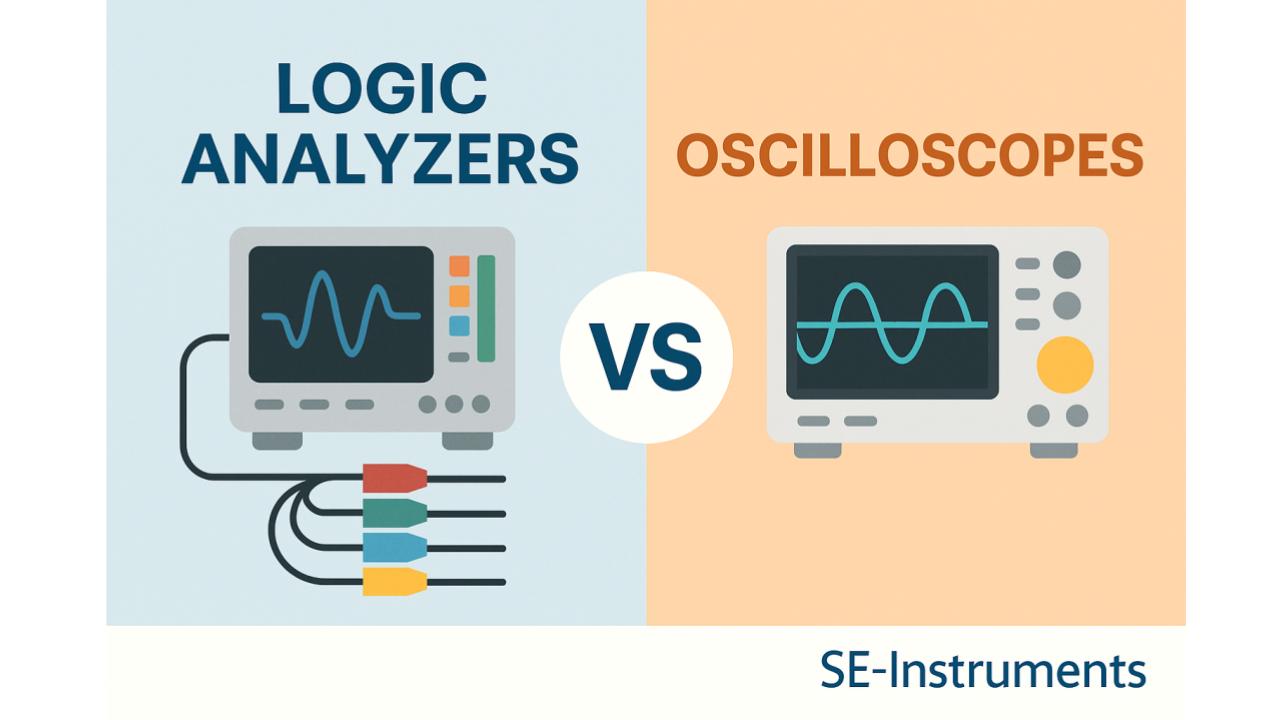When it comes to diagnosing and understanding electronic circuits, both oscilloscopes and logic analyzers are indispensable instruments—but they serve distinct roles.
In this article, we’ll explore the differences between these two tools, provide a side-by-side comparison, and offer product recommendations to help you choose the right instrument for your projects. We also discuss Oscilloscope and Logic Analyzer Combination Instruments called Mixed Signal Oscilloscopes (MSO)
🏷️ Oscilloscope Deals ⭐⭐⭐⭐⭐
Table of Contents
Understanding the Instruments
Oscilloscopes
Oscilloscopes are designed primarily for observing analog signals. They display a signal’s voltage over time, offering a continuous, detailed waveform view. This makes them ideal for:
- Signal Integrity Analysis: Visualizing transient phenomena, noise, and waveform distortions.
- High-Frequency Measurements: Capturing fast events thanks to high sampling rates.
- Troubleshooting Analog Circuits: Diagnosing issues in power supplies, RF systems, and sensor outputs.
Modern digital oscilloscopes also incorporate advanced features like Fast Fourier Transform (FFT) for basic spectrum analysis, making them even more versatile.
Logic Analyzers
Logic analyzers, on the other hand, focus on digital signals. They capture multiple digital channels simultaneously and display data in the form of timing diagrams. Their strengths include:
- Digital Debugging: Monitoring microcontroller communications, digital buses, and protocol signals.
- Multi-Channel Analysis: Handling complex systems by displaying many channels at once.
- Protocol Decoding: Offering built-in tools for interpreting protocols such as SPI, I²C, UART, and more.
These instruments are particularly useful when working with digital circuits or embedded systems where timing relationships between multiple signals are critical.
Comparison Table
Below is a comparison table highlighting the key differences between oscilloscopes and logic analyzers:
| Feature | Oscilloscope | Logic Analyzer |
|---|---|---|
| Primary Function | Visualize analog waveforms and transient events | Capture and analyze multiple digital signals simultaneously |
| Signal Type | Analog (continuous voltage variations) | Digital (binary high/low states) |
| Channel Count | Typically 2–4 channels | Often 16 channels or more, ideal for complex digital systems |
| Sampling Rate | High sampling rates to capture fast, transient signals | Sampling rate sufficient for digital edge detection |
| Display Output | Waveform graphs (voltage vs. time) | Timing diagrams that show digital state transitions and protocol data |
| Triggering Options | Advanced analog triggering (edge, pulse, video, etc.) | Digital event triggering with protocol-specific triggers |
| Applications | Analog circuit analysis, RF testing, sensor signal examination | Debugging digital circuits, verifying communication protocols |
| Cost Consideration | Generally available across a wide range, from budget to high-end | Varies based on channel count and speed; entry-level options are affordable |
Product Recommendations
Recommended Oscilloscopes
- Rigol DS1054Z
A popular 50 MHz digital oscilloscope that offers 4 channels and advanced measurement capabilities. Ideal for hobbyists and professionals alike, it balances performance and affordability. - Siglent SDS1104X-E
With a 100 MHz bandwidth and four channels, this oscilloscope is known for its fast sampling and robust feature set. It’s a solid choice for labs that require more detailed waveform analysis. - Tektronix TBS2000 Series
Renowned for their reliability and user-friendly interface, these oscilloscopes deliver excellent performance and are often used in both educational and professional settings.
Recommended Logic Analyzers
- Saleae Logic Pro 16
Offering up to 16 channels and high-speed capture, this analyzer is excellent for complex digital systems. Its intuitive software and powerful analysis capabilities make it a favorite among embedded developers. - Saleae Logic 8
For projects on a tighter budget, the Logic 8 provides an effective balance of cost and performance while still offering essential features for digital debugging. - Digilent Digital Discovery
This multifunction device acts as a logic analyzer, protocol analyzer, and pattern generator in one package. It’s a versatile tool for developers working on digital electronics and embedded systems.
What Is a Mixed Signal Oscilloscope (MSO)?
A Mixed Signal Oscilloscope merges the capabilities of a digital storage oscilloscope and a logic analyzer. It allows users to:
- Visualize analog waveforms (voltage over time)
- Capture and decode digital signals (logic levels, protocols)
- Correlate analog and digital events in real time
MSOs typically provide 2–4 analog channels (for traditional oscilloscope measurements) and 8–16 or more digital channels (for logic analysis). This enables simultaneous viewing of analog phenomena and digital transitions.
Key Benefits
- Time-correlated analog and digital capture: See how analog glitches affect digital logic, or vice versa.
- Integrated protocol decoding: Analyze I2C, SPI, UART, CAN, and other buses directly on the instrument.
- Space and cost efficiency: One instrument replaces two, saving bench space and budget.
- Advanced triggering: Set triggers based on analog or digital events, or a combination of both.
Typical Applications
- Embedded system debugging
- Microcontroller and FPGA development
- Serial bus analysis and protocol decoding
- Mixed-signal circuit troubleshooting
- Educational labs and prototyping
Recommended Logic Analyzer & Oscilloscope Combo Instruments
Below are some of the most popular and well-regarded MSOs and combo devices available today:
| Product | Analog Channels | Digital Channels | Bandwidth | Notable Features | Typical Price |
|---|---|---|---|---|---|
| Rigol MSO5074 | 4 | 16 | 70 MHz | Large touchscreen, protocol decoding, spectrum analysis | Check Price |
| Siglent SDS824X HD | 4 | 16 | 200 MHz | Deep memory, advanced triggers, protocol analysis | Check Price |
| PicoScope 3406D | 4 | 16 | 50–200 MHz | USB PC-based, deep memory, compact | Check Price |
| Analog Discovery 2/3 | 2 | 16 | 30 MHz | USB, portable, waveform generator, low cost | Check Price |
Product Highlights
Rigol MSO5074
- Combines oscilloscope, logic analyzer, spectrum analyzer, and more in one unit.
- Touchscreen, up to 350 MHz bandwidth, deep memory, and protocol decoding.
- Praised for value and features in its class.
Siglent SDS824X HD
- Offers advanced triggering, deep memory, and 16 digital channels.
- Protocol analysis for common serial buses.
- Reliable performance for both analog and digital debugging.
PicoScope 3406D
- PC-based, compact, and affordable.
- Up to 16 digital channels and deep memory.
- Suitable for labs, field work, and educational use.
Analog Discovery 2/3
- Portable, USB-powered, and affordable.
- 2 analog and 16 digital channels, plus waveform generation.
- Popular in education and hobbyist communities.
Choosing the Right Combo Instrument
Consider the following when selecting an MSO or combo device:
- Bandwidth and sample rate (match to your highest-frequency signals)
- Number of analog and digital channels (based on your project needs)
- Protocol decoding support (I2C, SPI, UART, CAN, etc.)
- Form factor (benchtop vs. portable/PC-based)
- Budget
Summary
Choosing between an oscilloscope and a logic analyzer depends largely on the nature of your signal analysis needs.
If you’re dealing with analog signals or require detailed waveform analysis, an oscilloscope is your best bet. Conversely, if your work involves debugging digital circuits and understanding complex digital protocols, a logic analyzer is the tool of choice.
Logic analyzer and oscilloscope combination instruments (MSOs) are indispensable for anyone working with mixed-signal systems. They offer unmatched insight into the interplay between analog and digital domains, streamline debugging, and save space and cost. Whether you’re a professional engineer, student, or hobbyist, there’s a combo instrument to fit your needs and budget.






